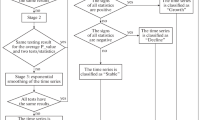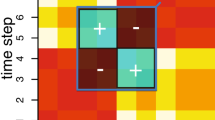Abstract
The gap in statistics between multi-variate and time-series analysis can be bridged by using entropy statistics and recent developments in multi-dimensional scaling. For explaining the evolution of the sciences as non-linear dynamics, the configurations among variables can be important in addition to the statistics of individual variables and trend lines. Animations enable us to combine multiple perspectives (based on configurations of variables) and to visualize path-dependencies in terms of trajectories and regimes. Path-dependent transitions and systems formation can be tested using entropy statistics.

Similar content being viewed by others
Notes
More recently, vector autoregression models are developed that capture linear interdependencies among a limited number of time series (Abdulnasser 2004).
Probabilistic entropy (H) is coupled to thermodynamic entropy (S) by Gibbs entropy formula: S = k B × H. In this formula, k B is the Boltzmann constant with dimensionality Joule/Kelvin. H is dimensionless and, for example, expressed in bits of information. Because of the second law both S and H necessarily increase or, in other words, the change in information (uncertainty) is always positive.
The stand-alone program VOSViewer uses the approach of MDS, but the current version does not provide stress values (Van Eck and Waltman 2010).
The dynamic version of Visone is freely available at http://www.leydesdorff.net/visone.
A different class of models is provided by actor-based models for network dynamics (e.g., Snijders et al. 2010).
References
Abdulnasser, H.-J. (2004). Multivariate tests for autocorrelation in the stable and unstable VAR models. Economic Modelling, 21(4), 661–683.
Agarwal, P., & Searls, D. B. (2008). Literature mining in support of drug discovery. Briefings in bioinformatics, 9(6), 479–492.
Agarwal, P., & Searls, D. B. (2009). Can literature analysis identify innovation drivers in drug discovery? Nature Reviews Drug Discovery, 8(11), 865–878.
Arthur, W. B. (1989). Competing technologies, increasing returns, and lock-in by historical events. Economic Journal, 99, 116–131.
Bak, P., & Chen, K. (1991). Self-organized criticality. Scientific American, 264(1), 46–53.
Bak, P., Tang, C., & Wiesenfeld, K. (1987). Self-organized criticality: an explanation of the 1/f noise. Physical Review Letters, 59(4), 381–384.
Barabási, A. L., & Albert, R. (1999). Emergence of scaling in random networks. Science, 286(5439), 509–512.
Bar-Hillel, Y. (1955). An examination of information theory. Philosophy of Science, 22, 86–105.
Baur, M., Benkert, M., Brandes, U., Cornelsen, S., Gaertler, M., Köpf, B., et al. (2002). Visone software for visual social network analysis. Proceedings of the 9th international symposium graph srawing (GD’01). Lecture Notes of Computer Science, 2265, 554–557.
Baur, M. & Schank, T. (2008). Dynamic graph drawing in visone. Technical University Karlsruhe, Karlsruhe. Available at http://i11www.iti.uni-karlsruhe.de/extra/publications/bs-dgdv-08.pdf (retrieved on 2 May 2012).
Börner, K. (2010). Atlas of science: visualizing what we know. Cambridge: MIT Press.
Bornmann, L., & Mutz, R. (2011). Further steps towards an ideal method of measuring citation performance: the avoidance of citation (ratio) averages in field-normalization. Journal of Informetrics, 5(1), 228–230.
Brandes, U. & Wagner, D. (2004). Visone—analysis and visualization of social networks. In: M. Jünger & P. Mtuzel (Eds.), Graph drawing software (pp. 321–340), Berlin: Springer.
Callon, M., Courtial, J. P., & Laville, F. (1991). Co-word analysis as a tool for describing the network of interactions between basic and technological research: the case of polymer chemistry. Scientometrics, 22(1), 155–205.
Callon, M., Law, J., & Rip, A. (Eds.). (1986). Mapping the dynamics of science and technology. London: Macmillan.
Chen, C. (2004). Information visualization: beyond the horizon. New York: Springer.
Chen, C. (2006). CiteSpace II: detecting and visualizing emerging trends and transient patterns in scientific literature. Journal of the American Society for Information Science and Technology, 57(3), 359–377.
Cook, T., & Campbell, D. (1979). Quasi-experimentations: design and analysis issues for field-settings. Boston: Houghton Mifflin Company.
David, P. A. (1985). Clio and the economics of QWERTY. American Economic Review, 75, 332–337.
Dolfsma, W., & Leydesdorff, L. (2009). Lock-in and break-out from technological trajectories: modeling and policy implications. Technological Forecasting and Social Change, 76(7), 932–941.
Erten, C., Harding, Ph.J., Kobourov, S.G., Wampler, K., & Yee, G.V. (2004). GraphAEL: graph animations with evolving layouts (pp. 98–110). In: Liotta, G. (Ed.), Graph drawing, Perugia, Italy, 21–24 Sept 2003; Berlin: Springer.
Fagerberg, J., Mowery, D. C., & Nelson, R. R. (2005). The oxford handbook of innovation. Oxford: Oxford University Press.
Gansner, E. R., Koren, Y., & North, S. (2005). Graph drawing by stress majorization. In J. Pach (Ed.), Graph drawing, lecture notes in computer science (Vol. 3383, pp. 239–250). Berlin/Heidelberg: Springer.
Griliches, Z. (1994). Productivity, R&D and the data constraint. American Economic Review, 84(1), 1–23.
Helbing, D., & Balietti, S. (2011). How to create an innovation accelerator. The European Physical Journal-Special Topics, 195(1), 101–136.
Hodgson, G., & Knudsen, T. (2011). Darwin’s conjecture: the search for general principles of social and economic evolution. Chicago/London: University of Chicago Press.
Kamada, T., & Kawai, S. (1989). An algorithm for drawing general undirected graphs. Information Processing Letters, 31(1), 7–15.
Kauffman, S. A. (1993). The origins of order: self-organization and selection in evolution. New York: Oxford University Press.
Klavans, R., & Boyack, K. W. (2011). Using global mapping to create more accurate document-level maps of research fields. Journal of the American Society for Information Science and Technology, 62(1), 1–18.
Krippendorff, K. (1986). Information theory. Structural models for qualitative data. Beverly Hills: Sage).
Krippendorff, K. (2009). Information of interactions in complex systems. International Journal of General Systems, 38(6), 669–680.
Kruskal, J. B. (1964). Multidimensional scaling by optimizing goodness of fit to a nonmetric hypothesis. Psychometrika, 29(1), 1–27.
Kruskal, J. B., & Wish, M. (1978). Multidimensional scaling. Beverly Hills: Sage Publications.
Kullback, S., & Leibler, R. A. (1951). On Information and sufficiency. The Annals of Mathematical Statistics, 22(1), 79–86.
Lengyel, B., & Leydesdorff, L. (2011). Regional innovation systems in Hungary: the failing synergy at the national level. Regional Studies, 45(5), 677–693. doi:10.1080/00343401003614274.
Leydesdorff, L. (1991). The static and dynamic analysis of network data using information theory. Social Networks, 13, 301–345.
Leydesdorff, L. (1995). The challenge of scientometrics: the development, measurement, and self-organization of scientific communications. Leiden: DSWO Press, Leiden University; at http://www.universal-publishers.com/book.php?method=ISBN&book=1581126816.
Leydesdorff, L. (1997). Why words and co-words cannot map the development of the sciences. Journal of the American Society for Information Science, 48(5), 418–427.
Leydesdorff, L. (2000). Is the European Union becoming a single publication system? Scientometrics, 47(2), 265–280.
Leydesdorff, L. (2002). The complex dynamics of technological innovation: a comparison of models using cellular automata. Systems Research and Behavioural Science, 19(6), 563–575.
Leydesdorff, L. (2003). The mutual information of university–industry–government relations: an indicator of the triple helix dynamics. Scientometrics, 58(2), 445–467.
Leydesdorff, L. (2010). The communication of meaning and the structuration of expectations: giddens’ “structuration theory” and Luhmann’s “self-organization”. Journal of the American Society for Information Science and Technology, 61(10), 2138–2150.
Leydesdorff, L. (2011). “Structuration” by intellectual organization: the configuration of knowledge in relations among scientific texts. Scientometrics, 88(2), 499–520.
Leydesdorff, L., Bornmann, L., Mutz, R., & Opthof, T. (2011). Turning the tables in citation analysis one more time: principles for comparing sets of documents. Journal of the American Society for Information Science and Technology, 62(7), 1370–1381.
Leydesdorff, L., Cozzens, S. E., & van den Besselaar, P. (1994). Tracking areas of strategic importance using scientometric journal mappings. Research Policy, 23, 217–229.
Leydesdorff, L., & Oomes, N. A. (1999). Is the European monetary system converging to integration? Social Science Information, 38(1), 57–86.
Leydesdorff, L., & Rafols, I. (2012). Interactive overlays: a new method for generating global journal maps from web-of-science data. Journal of Informetrics, 6(3), 318–332.
Leydesdorff, L., Rotolo, D., & de Nooy, W. (in press). Innovation as a nonlinear process, the scientometric perspective, and the specification of an “innovation opportunities explorer”, Technology Analysis and Strategic Management.
Leydesdorff, L., Rotolo, D., & Rafols, I. (2012b). Bibliometric perspectives on medical innovation using the medical subject headings (MeSH) of PubMed. Journal of the American Society for Information Science and Technology, 63(11), 2239–2253.
Leydesdorff, L., & Schank, T. (2008). Dynamic animations of journal maps: indicators of structural change and interdisciplinary developments. Journal of the American Society for Information Science and Technology, 59(11), 1810–1818.
Leydesdorff, L., Schank, T., Scharnhorst, A., & De Nooy, W. (2008). Animating the development of social networks over time using a dynamic extension of multidimensional scaling. El Profesional de la Información, 17(6), 611–626.
Leydesdorff, L., & Zawdie, G. (2010). The triple helix perspective of innovation systems. Technology Analysis and Strategic Management, 22(7), 789–804.
Liu, Z., & Stasko, J. T. (2010). Mental models, visual reasoning and interaction in information visualization: a top-down perspective. Visualization and Computer Graphics, IEEE Transactions on, 16(6), 999–1008.
Luhmann, N. (1990). The cognitive program of constructivism and a reality that remains unknown. In: W. Krohn, G. Küppers & H. Nowotny (Eds.), Selforganization. Portrait of a scientific revolution (pp. 64–85). Dordrecht: Reidel.
Luhmann, N. (1995). Social systems. Stanford: Stanford University Press.
Malerba, F., Nelson, R., Orsenigo, L., & Winter, S. (1999). ‘History-firendly’ models of industry evolution: the computer industry. Industrial and Corporate Change, 8(1), 3–35.
McLuhan, M. (1964). Understanding media: the extension of man. New York: McGraw-Hill.
Misue, K., Eades, P., Lai, W., & Sugiyama, K. (1995). Layout adjustment and the mental map. Journal of Visual Languages and Computing, 6(2), 183–210.
Nagin, D. S. (2005). Group-based modeling of development. Cambridge: Harvard University Press.
Noyons, E. C. M., & van Raan, A. F. J. (1998). Monitoring scientific developments from a dynamic perspective: self-organized structuring to map neural network research. Journal of the American Society for Information Science, 49(1), 68–81.
Park, H. W., & Leydesdorff, L. (2010). Longitudinal trends in networks of university-industry-government relations in South Korea: the role of programmatic incentives. Research Policy, 39(5), 640–649.
Price, D. S. (1976). A general theory of bibliometric and other cumulative advantage processes. Journal of the American Society for Information Science, 27(5), 292–306.
Price, D.de Solla. (1984). The science/technology relationship, the craft of experimental science, and policy for the improvement of high technology innovation. Research Policy, 13, 3–20.
Prigogine, I., & Stengers, I. (1984). Order out of Chaos: man’s new dialogue with nature. New York: Bantam.
Pyka, A., & Scharnhorst, A. (Eds.). (2009). Innovation networks: new approaches in modelling and analyzing. Berlin/Heidelberg: Springer.
Scharnhorst, A., Börner, K., & Van den Besselaar, P. (Eds.). (2012). Models of science dynamics: encounters between complexity theory and information sciences. Heidelberg: Springer.
Seglen, P. O. (1992). The skewness of science. Journal of the American Society for Information Science, 43(9), 628–638.
Shannon, C.E. (1948). A mathematical theory of communication. Bell System Technical Journal, 27, 379–423 and 623–356.
Sheskin, D. J. (2011). Handbook of parametric and nonparametric statistical procedures (5th ed.). Boca Raton: Chapman and Hall/CRC.
Shinn, T. (2005). New sources of radical innovation: research-technologies, transversality and distributed learning in a post-industrial order. Social Science Information, 44(4), 731–764.
Snijders, T. A. B., Van de Bunt, G. G., & Steglich, C. E. G. (2010). Introduction to stochastic actor-based models for network dynamics. Social Networks, 32(1), 44–60.
Strand, O., & Leydesdorff, L. (in press). Where is synergy in the Norwegian innovation system indicated? Triple helix relations among technology, organization, and geography. Technological Forecasting and Social Change.
Theil, H. (1972). Statistical decomposition analysis. Amsterdam/London: North-Holland.
Van Eck, N. J., & Waltman, L. (2010). Software survey: vOSviewer, a computer program for bibliometric mapping. Scientometrics, 84(2), 523–538.
Von Hippel, E. (1976). The dominant role of users in the scientific instrument innovation process. Research Policy, 5(3), 212–239.
Von Hippel, E. (1988). The sources of innovation. New York/Oxford: Oxford University Press.
Yeung, R. W. (2008). Information theory and network coding. New York: Springer.
Author information
Authors and Affiliations
Corresponding author
Rights and permissions
About this article
Cite this article
Leydesdorff, L. Statistics for the dynamic analysis of scientometric data: the evolution of the sciences in terms of trajectories and regimes. Scientometrics 96, 731–741 (2013). https://doi.org/10.1007/s11192-012-0917-0
Received:
Published:
Issue Date:
DOI: https://doi.org/10.1007/s11192-012-0917-0




